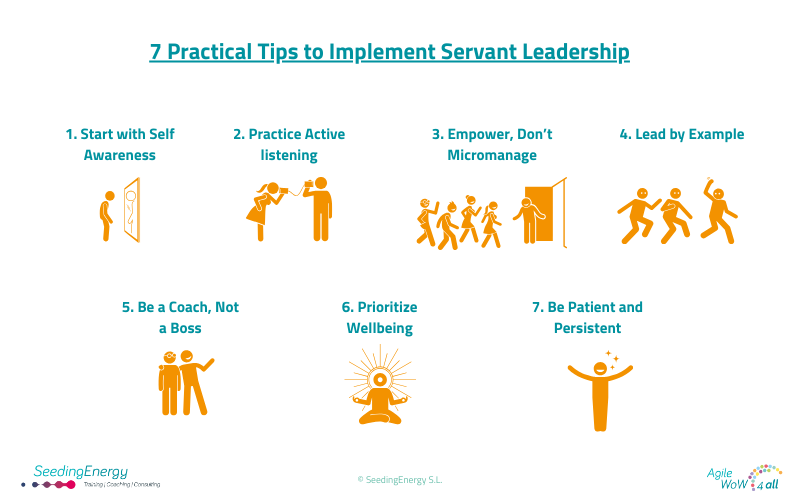

12/09/2024
Servant Leadership: Understanding It is Easy, Implementing It is the Challenge
7 Practical Tips to Implement Servant Leadership and Empower Your Team
Servant Leadership has emerged as a popular and powerful leadership model in recent years, often discussed in corporate boardrooms, team meetings, and leadership conferences. Many organizations have embraced the concept of “serving others first,” and leadership as a tool to empower teams has resonated with countless leaders across industries. However, while many people can easily grasp the theory, implementing servant leadership in day-to-day operations is where the real challenge lies.
The core principle of servant leadership—prioritizing the needs of others before your own—may seem straightforward in theory. Yet, leaders often struggle to put this into practice in environments that are fast-paced, results-driven, and pressured by constant change. So, how can we move from understanding what servant leadership is to effectively implementing it?
Here are some practical tips to help turn the theory into action:
1. Start with Self-Awareness
Servant leadership begins with understanding yourself before you can serve others effectively. Self-awareness allows you to recognize your own strengths and limitations, biases, and tendencies. It means acknowledging that, as a leader, you don’t have all the answers and might sometimes need support from your team. Leaders who practice self-awareness make more mindful decisions and foster environments where transparency and vulnerability are embraced. We use some great tools that can help you increase your self-awareness: Insights Discovery©.
Tip: Take time to reflect on your leadership style. Ask for feedback from your team about how they perceive your leadership. Create regular opportunities for self-assessment to stay aligned with servant leadership principles.
2. Practice Active Listening
One of the key skills in servant leadership is listening actively. It is more than just hearing what someone says; it involves understanding the deeper meaning behind their words. As a servant leader, listening to the concerns, ideas, and feedback of your team is crucial to fostering trust and building strong relationships.
Tip: In your meetings and one-on-ones, focus on listening more than talking. Avoid interrupting, and seek to understand, not just respond. When people feel heard, they are more likely to trust you and engage fully.
3. Empower, Don’t Micromanage
Servant leaders don’t dictate solutions; they empower their teams to find their own answers. This shift can be difficult for leaders used to maintaining tight control, but it is essential for fostering autonomy and innovation within teams. Micromanagement stifles creativity, whereas empowerment creates an environment where people take ownership and feel more invested in their work.
Tip: Provide clear guidance and resources, but give your team the freedom to explore different approaches. Encourage them to take initiative and make decisions, even if it means allowing room for mistakes and learning opportunities.
4. Lead by Example
Servant leaders are role models who inspire others through their actions, not their titles. They are willing to step into the trenches alongside their teams, demonstrating humility and dedication. Leading by example means being consistent with the values you promote—whether it’s integrity, empathy, or a strong work ethic.
Tip: Demonstrate servant leadership through your behavior. If you want your team to be collaborative, show collaboration in how you work with others. If you value transparency, be transparent in your communication and decision-making.
5. Be a Coach, Not a Boss
Servant leadership involves coaching your team to reach their full potential, rather than just managing tasks. A coach is someone who invests time in developing others, providing feedback, and helping team members grow professionally and personally. This developmental focus builds a stronger, more resilient team over time.
Tip: Regularly check in with your team members about their development goals. Offer constructive feedback and opportunities for growth. Support them in overcoming challenges, but also encourage them to stretch beyond their comfort zones.
6. Prioritize Wellbeing
In fast-paced environments, it’s easy to get caught up in deadlines and deliverables, but a servant leader always considers the wellbeing of their team. Overworking teams without considering their mental, emotional, and physical health leads to burnout. Servant leaders create an environment where work-life balance is respected, and wellbeing is seen as essential to productivity.
Tip: Promote a culture where balance is valued. Encourage breaks, time off, and mental health support. Check in with your team members regularly, not just about their work, but about how they’re doing personally. Create space for open discussions about workload and stress management.
7. Be Patient and Persistent
Implementing servant leadership doesn’t happen overnight. Changing old habits, especially in leadership roles, can be difficult. It takes time, effort, and persistence to see real transformation. Start small, be consistent, and recognize that servant leadership is a journey, not a quick fix.
Tip: Be patient with yourself and your team. Celebrate small wins along the way and recognize progress, even if it’s gradual. Continuous learning and adaptation are key to staying true to servant leadership principles.

Servant Leadership is a Mindset Shift
Ultimately, servant leadership is not just a set of behaviours; it’s a mindset shift. It requires a fundamental change in how you see your role as a leader—from one who controls and directs to one who serves and empowers. This mindset shift can transform your team’s dynamics, improve trust and collaboration, and foster long-term success.
The challenge isn’t in understanding servant leadership—it’s in practising it daily. By focusing on listening, empowering, leading by example, and prioritizing the well-being of your team, you can move from knowing what servant leadership is to truly living it.
In the end, servant leadership is about one thing: putting people first. And when you do that, success follows.
By applying these strategies and staying committed to the servant leadership philosophy, you’ll create an environment where your team can thrive, both personally and professionally. The journey may be challenging, but the rewards—for both your team and yourself—are well worth it.
We can help accompany you and your team leaders to develop those skills and behaviors. If you want to learn more, please do not hesitate to contact us!
